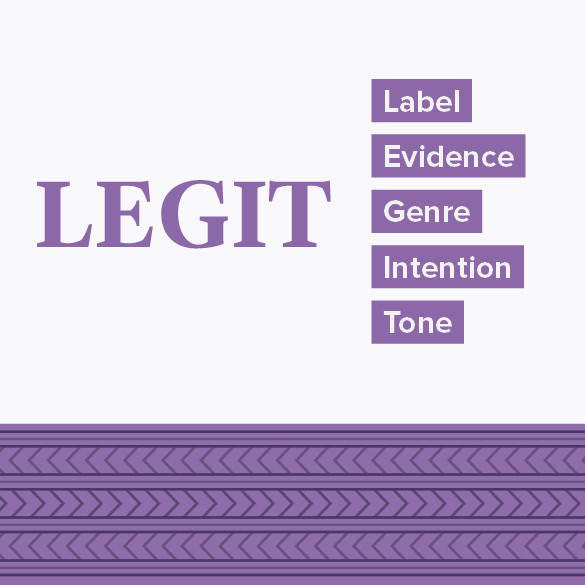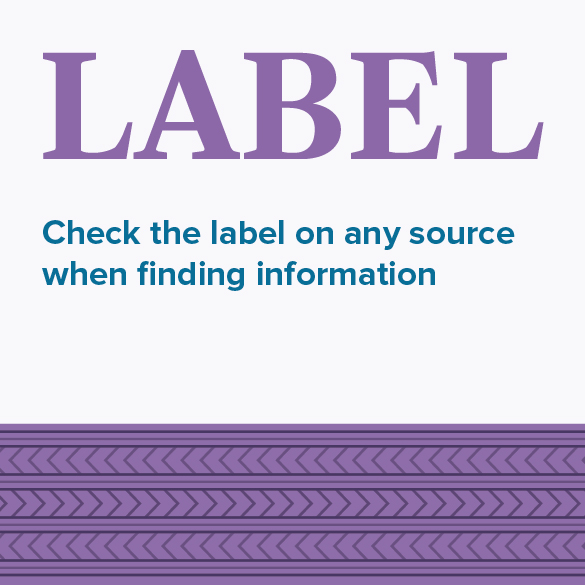Using this page
This page provides a summary of how students can use the LEGIT tool to critically interpret and evaluate sources of information.
Curriculum
This page supports an integrated approach to teaching the big ideas of Aotearoa New Zealand histories. It would be particularly useful for the Do element of the content, which encourages students to think critically about the past and interpret stories about it.
Key concepts
- Identifying sources and perspectives.
What is LEGIT?
In this digital age where we are saturated with enormous amounts of information, it has never been more important for students to develop skills that allow them to consume information critically.
Evaluating information LEGIT resource (PDF, 95KB)
LEGIT is a tool that can be used for interpreting and evaluating texts. It plays on common question heard in the classroom of whether something is legit. Within the memorable acronym are a series of prompts and questions that can be posed to any text.
- Label
- Evidence
- Genre
- Intention
- Tone
Label
Just like when you buy a top and check the label, we need to check the label on any source we think looks good when we are finding information.
There are all kinds of sources you can use. Here are some questions to think about when you are checking the credibility of the source.
Label resource for source information (PDF, 95KB)
For a written source:
- Look for the name of the writer/speaker
- Click on the writer’s name and/or type their name into Google
- Ask yourself:
- Is this person knowledgeable about this topic?
- Where did they write this? Can we trust that place?
- When was it made – does this influence what is said?
- Is this info is up-to-date (if it needs to be)?
If the answer is yes to these questions then they are a credible author on your topic.
For a person in a video:
- Use the same steps as for a written source
For a person you talk to:
- Were they there? Are they talking about their own experiences?
- Are they an expert on what they are talking about if they were not there?
For objects/photo/places:
- Who made it?
- When?
- Why?
- What can we infer from it?
- What can we not tell from it?
No author on the internet?
Sometimes there is no author name. In this case you need to think of the website as the author and ask the same questions.
Evidence
A good source uses credible (reliable) evidence.
Evidence comes in many forms and includes:
- Statistics
- Specific names, dates and places
- Direct quotes
- Tables
- Graphs
- Oral accounts by experts
- First-hand accounts
- Quotes from studies or research
Ask these questions:
- Does this source use any evidence to back up its points?
- What is that evidence?
- Does it say where the evidence came from, or who said it?
- Can we trust that person or organisation?
- Is the information up-to-date?
What if I just talk to my family? Do they have credible evidence?
It depends what you ask them. If you are asking them about their opinions, about things they have experienced or areas that they are trained in then YES.
If you are asking them about stuff they have not experienced or know nothing about then NO.
Can I use a myth as a credible source?
Yes. If you say where it came from and if the person who told the myth is knowledgeable. Myths give us rich insights into culture, but we need to remain wary about using them as ‘facts’. Myths often contain symbolism and can be interpreted in several ways.
Remember:
You might not agree with how the author has interpreted the evidence, but that does not make it a bad source.
Genre
What kind of source it is?
Is it a primary or a secondary source?
You can extend Genre with senior students so that you consider the aesthetic or ideological form of a text. This can help contextualise a text within a ‘school of thought’. For example, you might read a ‘feminist’ or ‘revisionist’ text. This is where students can consider historiography – the way history has been written and interpreted.
In Year 13 and scholarship history you must analyse historical interpretations. This involves working out the approach the historian is using and critiquing or evaluating these interpretations.
Intention
What is the purpose of the text?
Why does the text exist? Is it to entertain, persuade, inform?
What are the key messages, ideas or arguments?
Who is the text for – which audience?
Tone
How does the text sound?
Is it biased, informed, balanced, persuasive?
As British historian Edward Hallett Carr said, 'when you read a work of history, always listen out for the buzzing. If you can detect none, either you are tone deaf or your historian is a dull dog.'
Analysing the tone of a text can be hard. Paying attention to adjectives can help and sometimes Tone relates to Evidence and Intention.



Community contributions